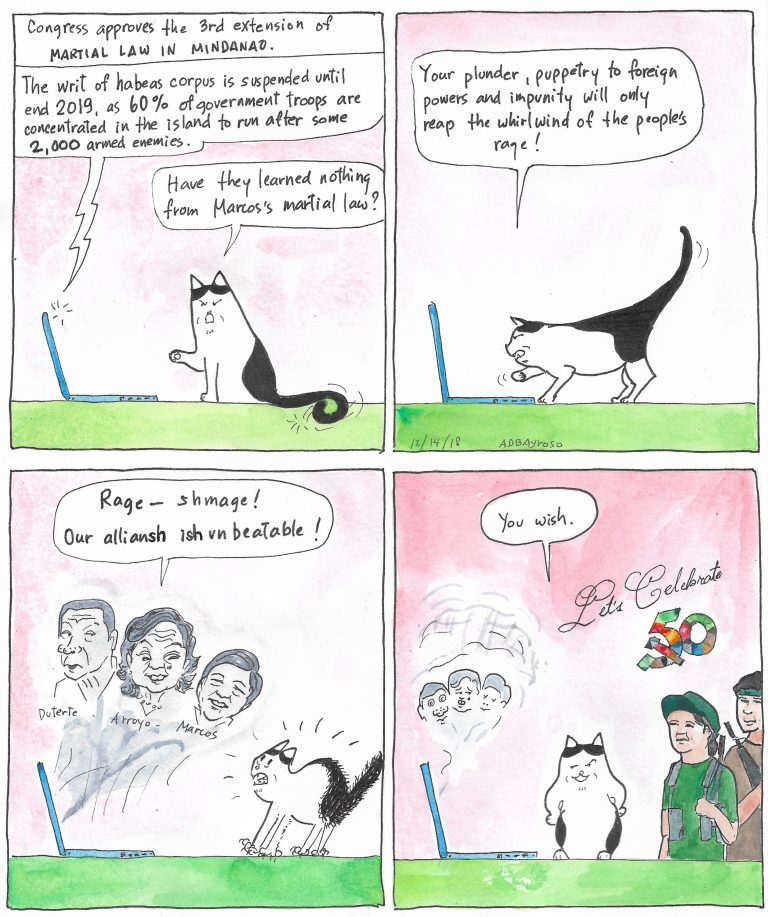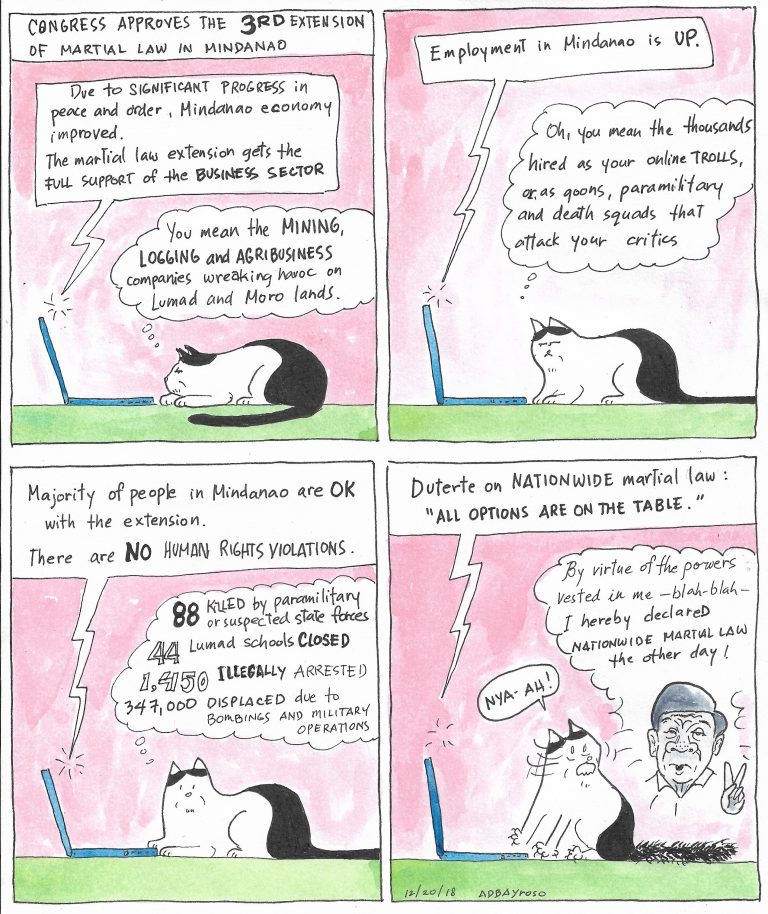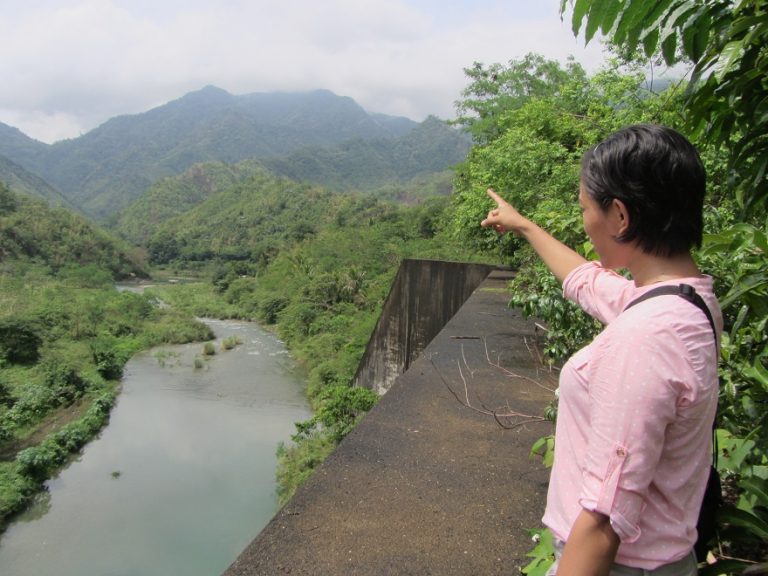HR defenders denounce police crackdown in Negros Oriental
CPP celebrates 50th anniversary
By RAYMUND B. VILLANUEVA
Kodao Productions / Bulatlat
The Communist Party of the Philippines (CPP) celebrated its 50th founding anniversary Dec. 26 in many regions nationwide despite the government’s refusal to reciprocate its unilateral ceasefire declaration, the group’s information bureau announced.
“In the guerrilla areas, NPA (New People’s Army) Red fighters and Party members gathered in fiesta-like assemblies together with the peasant masses from nearby barrios with food and cultural programs,” the CPP said in a statement.
The NPA implemented its temporary ceasefire since December 24 despite relentless military offensives by Armed Forces of the Philippines (AFP). No fire fights happened during the NPA’s unilateral ceasefire from December 24 to 26.
“In the cities, Party members and activists held meetings and small gatherings under the nose of police and military intelligence agents,” the group’s information bureau revealed.
Last week, members of the Revolutionary Council of Trade Unions, an underground organization of workers, held a rally in downtown Manila as a “warm up” activity prior to yesterday’s anniversary.
Abroad, a rally was held in Hong Kong last Sunday by Filipino migrants in unity with the CPP celebrations.
An assembly was also planned in The Netherlands where the National Democratic Front of the Philippines (NDFP) International Office is based, the CPP said.
President Rodrigo Duterte ordered Saturday the destruction of all Reds, both combatants and civilians, marking the first Christmas and New Year that his government refused to declare a ceasefire.
NPA victories
In response to ongoing military operations against communists, NPA guerrillas staged tactical offensives in the Bicol region, Kalinga Province in the North, Compostela Valley in Mindanao and Northern Samar in the Visayas, scoring victories that netted them dozens of firearms while inflicting casualties on both AFP and paramilitary forces.
In Barangay Western Uma in Lubuagan, Kalinga last December 23, Sunday, the NPA’s Lejo Cawilan Command overran a detachment of the 77th Infantry Battalion of the Philippine Army (PA) and carted away 30 firearms.
The detachment’s commander, a Sergeant Elon D. Bayan, was reportedly killed while three paramilitary troopers were injured. The NPA said they also suffered one casualty in the attack.
The NPA accused the said unit and its Citizens Armed Force Geographical Unit (Cafgu) of harassing and restricting the movements of residents in the area whom they accuse of being rebel supporters.
The government troopers also instigated gambling and “anti-social” activities in the communities, the NPA said.
The attack followed another raid of a military patrol base in Barangay New Tubigon, Sibagat town, Agusan del Sur where they carted away 24 high powered firearms “without firing a single shot.”
The Red Fighters also took two soldiers of the 3rd Special Forces Battalion and 12 paramilitary troopers captive. The NPA assured that their prisoners of war are being treated humanely under International Humanitarian Laws.
Earlier, the NPA also launched successful tactical offensives in Sorsogon and Northern Samar provinces.
In Las Navas town in Northern Samar last December 22, a government soldier was killed while two others when attacked by the NPA.
Army Private First Class Alvin Avila died on the spot while Private Ivan Anthony Ignao Michael Ocasla were wounded.
The NPA in Sorsogon attacked a Philippine National Police station in Magallanes town, inflicting injuries on three police personnel before withdrawing after a ten-minute fire fight.
Aside from projecting nationwide strength on the CPP’s 50th founding anniversary, the successive NPA attacks are seen as the guerrillas’ response to massive military operations against civilian communities.
Since early December bombings and military operations in the Kalabugao plains straddling the tri-boundary of Agusan del Sur, Bukidnon and Misamis Oriental in Mindanao have forced indigenous peoples and civilian communities to flee.
Col. Edgardo de Leon, commander of the 403rd Infantry Brigade, said the bombings and military operations are meant to disrupt the CPP’s anniversary celebrations.
“We discovered a major NPA hideout that is probably a projected venue of the CPP anniversary celebration,” de Leon said.
Meanwhile, CPP and NDFP’s respective websites, prwc.net and ndfp.org have become inaccessible since yesterday.
“The CPP’s website became inaccessible as it was under attack likely by the US-trained AFP cyberwarfare group. But in social media, the hashtags #CPP50 and #LetsCelebrate were the top Twitter trending topics in the Philippines for several hours since early morning and was still trending as of mid afternoon,” the CPP Information Bureau said.
The post CPP celebrates 50th anniversary appeared first on Bulatlat.
Reds in Bicol vow to frustrate Duterte’s ‘counterinsurgency’ ops
“In any war, the people are the most decisive and so, the military will never be able to crush the Party.”
By RONALYN V. OLEA
Bulatlat.com
BICOL REGION – A few weeks after President Rodrigo Duterte signed Memorandum Order No. 32 ordering the deployment of more troops to Bicol, Samar and Negros, the Romulo Jallores Command of the New People’s Army (RJC-NPA) declared that Duterte would fail to end the longest-running armed revolution in the world.
In a press conference somewhere in the mountainous part of the region last week, Raymond Buenferza, spokesperson of the RJC-NPA, said in Filipino, “The people’s army will never ever be defeated.”
Buenferza said that MO no. 32 and the subsequent Executive Order No. 70 outlining the government’s ‘national task force to end insurgency’ signal more rights violations in the region and in the entire country.
The NPA spokesperson said that the military targets civilians, adding that there have been 77 victims of extrajudicial killings in the region since Duterte assumed the presidency.
Buenferza said the NPA units in the region, in response to the “heightening calls for justice,” carried out 87 tactical offensives in 2018, killing 68 state security forces and wounding 48 others.
He cited the NPA ambush on a convoy of the Philippine National Police (PNP) in Lupi, Camarines Sur on Oct. 18 as punishment to policemen engaged in “anti-drug” operations. Three police officers were killed.
Buenferza said the Army’s 9th Infantry Battalion (IB) and the Task Force Bicolandia failed to crush the revolutionary movement in Bicol in 2018.
With the deployment of 49th IB, 42nd IB, Special Action Forces and Duterte death squads in the region, Buenferza said, the NPA in Bicol would have the opportunity to punish these units for their crimes against the people.
Using civilian agencies for military purposes
The revolutionary groups in Bicol also criticized EO 70 for including 14 civilian agencies in the so-called National Task Force To End Local Communist Armed Conflict.
Under the EO, civilian agencies such as the Department of Interior and Local Government, Department of Education, Department of Social Welfare and Development, Department of Justice, among others, are mandated to provide support to the task force.
Buenferza revealed that military units have signed memorandum of agreements with local government units in Bicol, forcing the latter to report activities of the revolutionary movement.
Michael Robredo, spokesperson of the NPA-Norben Gruta Command operating in West Camarines Sur, said that even before EO 70, soldiers have been occupying public places such as barangay halls and schools and even homes of civilians. “They are forcing people to provide information about the NPA,” Robredo said.
Optimistic

Still, the revolutionary forces in the region are confident they will continue to gain more strength.
Buenferza said that despite the continuous military operations in the region, the NPA has gained more strength and the mass base of the revolutionary forces has widened.
Samuel Guerrero, 69-year-old spokesperson of the NPA-Celso Minguez Command, said this is because the revolutionary movement is deeply rooted among the masses.
“In any war, the people are the most decisive and so, the military will never be able to crush the Party,” (referring to the Communist Party of the Philippines),” he said in Filipino.
Guerrero, who has been a guerrilla for 27 years, said the NPA is not just a fighting force but also implements agrarian revolution, participates in agricultural production, provides services to the poor, among others.
As the 50th anniversary of the CPP draws near, Guerrero looks forward to victory.
“They only comprise one percent of the population. If all the oppressed and the exploited would unite [against the ruling elite], we could defeat them,” he said.
The post Reds in Bicol vow to frustrate Duterte’s ‘counterinsurgency’ ops appeared first on Bulatlat.
In the Philippines, women play big roles in opposing mega-dam projects
By MARYA SALAMAT
This is a special report in a series produced by Bulatlat.com with the Asia-Pacific Forum on Women, Law and Development (APWLD) Media Fellowship. The series aims to report on linkages between gender, ecological conflicts and climate change.
Read also : In the Philippines, a dam struggle spans generations, inspires songs of unity for the environment
MANILA – Right now, tourists are likely enjoying a walk or sightseeing by the river of Daraitan in Tanay, Rizal, a mountainous province east of Manila. The clear water and the way huge slabs of rocks have been cleaved by the raging river, creating a challenging trek and a beautiful sight, and caves with pools of cool water inside, have attracted campers and backpackers to the villages around it especially in summer.
Inside one of the many caves in Rizal and Quezon the indigenous peoples, the Dumagat and Remontados, pray to their God, the creator they call Makijapat. The Dumagat live by planting food crops in the mountains, fishing, and hunting. The mountain forest and the watershed are key to their survival and also of those downstream. The mountain range has historically served to break or weaken strong typhoons and absorb excess water runoff. Given the grim forecast on climate change, its effects of generating some increasingly strong typhoons, or intense droughts, the Sierra Madre mountain range needs all the protection it can get to maintain or expand its forest and watershed.
But the indigenous peoples’ villages and the others farther upstream are in danger of losing it and all that the river sustains to mega-dam projects. The Dumagat and Remontados stand to be the most immediately affected – they are the first to be displaced. In fact, some of them are already bearing the brunt of the dam projects even as construction has been repeatedly stopped. The next to be affected are the farmers and communities downstream who would have to live with reduced guards against the impacts of climate change.
What the people in Quezon and Rizal have opposed and stopped successfully for four decades now since the Marcos dictatorship keeps resurfacing as a threat. The Duterte government’s “Build Build Build” projects constitutes the latest threat. It includes as one of the priorities the construction of large dams such as the Laiban dam, the Kaliwa (left) and Kanan (right) dams, or the Php12.2 billion New Centennial Water Source-Kaliwa Dam, which will be 85% funded by China. On Nov. 20, the Chinese leader visited Manila and one of the agreements he oversaw while here was China funding the new New Centennial Water Source Project.
These are dam projects that over the past years have been approved, cancelled, repackaged and renamed. Now, under the New Centennial Water Source-Kaliwa Dam Project, the Duterte administration targets to build the dams over more of the same rivers in Rizal and Quezon despite protests and proven negative impacts of large dams.
For Nanay Nene Baylon, the first Laiban dam project continues to exert a heavy toll on her family’s livelihood. The Laiban dam was eventually stopped by massive protests in the 80s, but by then its massive twin gates had been forcibly constructed in their village. It has since deprived her family and that of other Dumagat of their years-long farm land. They were planting vegetables and root crops on the piece of land that became the cleared hilltop of the dam’s humongous gates.



She told us her family and the others planting near them were neither compensated for the crops destroyed when the dam’s gates were constructed nor for the land that was forcibly taken away from them. A young wife and mother at the time of the construction under the Marcos dictatorship, she said the construction crew and machinery came without warning and despite their protests. She recalled how their villages were enveloped in thick dust stirred up by trucks and machinery which were escorted by government soldiers. The river turned muddy as workers and machine burrowed into and exploded parts of the mountain by the mouth of the river. Now Nanay Nene is older, but she remains emphatic for the struggle to stop the renewed drive to construct the series of dams.
The Laiban dam’s gates continue to be guarded by armed security. Two years ago, as news broke out that the dam project was being pushed by the Duterte administration, the guards of the unused dam gates stirred up anew the villagers’ outrage. The guards fired at and killed two Dumagat farmers who took a shortcut in going downstream, thus passing on top of the dam’s gates.
Climbing to what was once the Dumagat’s farm but is now overgrown by grasses, and yes, dominated by the top of the thick concrete wall of the gate, Nanay Nene’s lips thinned as she recalled the days of the gates’ construction. After it was stopped their communities by the river now look tranquil – the water became clear again and they are planting food again in other parts of the mountain upstream. But there is the ever-present threat that all this may end. A cheerful host, Nanay Nene’s expression rapidly turns fierce at recalling those days of military-escorted dam construction, and, decades later, security guards gunning down her fellow Dumagat for having passed through what’s actually their land.

She has been joining initiatives to oppose the renewed drive to build mega dams where they live. To their communities, it is a struggle not just for their right to the land and to their self-determination, but also a struggle to save the river, the remaining forest of Sierra Madre and the watershed in it.
It is a struggle demanding time, patience and courage to face not just their fellow Dumagat and the people in the cities, but also the militarization and the promises that if they are not careful, they could end up divided and scattered like the jagged rocks pushed apart by the Tinipak River.
Learning from dam Lessons
The Dumagat communities and the Filipinos in general have by now numerous tragic experiences with dams. People from north to south have been displaced by earlier dam construction without compensation or rehabilitation. Rivers have become more polluted, farms have lost irrigation when they needed it most, and were inundated with excess water when they needed it the least. People have died from the dams’ sudden or heavy release of water in times of typhoons. By now, scientists and environmentalists are saying, we should know better not to resort to building more dams. Add to this, the suspicions of progressives that the Philippines does not really need another dam.

Progressive lawmakers in Philippine Congress led by Bayan Muna, Gabriela, ACT, Anakpawis and Kabataan Partylist, said the news of water crisis hyped up in late 2016 is “manufactured to build up the necessity for the Kaliwa-Kanan-Laiban dams.”
Neither were the dam projects needed for energy because according to non-government thinktank Ibon Philippines, using data from the Dept. of Energy itself, there are enough sources of energy and it could still be increased beyond the Philippines’ projected needs if the current dams were rehabilitated.
With global warming and climate change, normal or extra-strong typhoons are becoming more disastrous than ever, offering more pressing reasons not to destroy the remaining forest and watershed to build unnecessary mega-dams, said the group AGHAM (Science for the People and Center for Environmental Concerns).
Dams have not brought the people cheaper and reliable energy, nor irrigation, as promised when the first dams were forcibly built, said peasant woman leader Zenaida Soriano of Amihan on another occasion. She has seen in peasants’ lives across the country how dams have wrecked the rivers and the environment, harmed the people’s agricultural practices and killed hundreds of people in periodic flooding and flashfloods. To this day, dam opponents are being surprised by bitter sharing that many had died from flashfloods without being reported in the news.
Danilo Peralta, 62, said some 317 died unreported as a result of sudden release of dam water in Umiray River in 2004. Today another dam, taking off from early 2000s when protests stalled it, is now being pushed to add to Sumag Dam in Umiray, the river in the boundary of Quezon and Aurora.
Dams have privatized the control of river, water and energy, further making life more difficult to women struggling to feed their family. In various fora, representatives of the Dumagat and others who have experienced dislocation due to dam building recounted how water was available to them for free before they were pushed away for the dam-building.
The people displaced by the construction of Angat Dam, Sumag Dam and Pantabangan Dam have experienced it and are warning those about to become like them: “When the day comes that you are forcibly driven away, you will not only have to pay for water that used to be free – you might not even have livelihoods so how will you pay, and live?”
The Duterte government’s revival of dam projects that have long been opposed by a broad coalition of people is nothing short of a declaration of war on the people, the Dumagat women leaders have been saying in various forum. To people like Nanay Nene, this war comes complete with military deployment and government agencies coming to their communities to “consult” and get their approval.
In some communities especially those likely to be enclosed in the planned dams in Quezon, young Dumagat women said the community members’ moves are being monitored and questioned by the military.
Some villages are regularly visited by government soldiers, or they could see armed government troops circling the village. Whenever the villagers talk in groups, soldiers would come asking what the talk is all about.
In Umiray village where one of the dam projects will be built, Imaset complained that their fellow Dumagat have been forced to live in a hamlet condition under military control and surveillance. They cannot go to work the field and they frequently went hungry. Shortly before the Dumagat formed the Imaset last August, they went on a rescue and relied mission with other support groups of the indigenous peoples.
Amid the palpable intimidation generated by the presence of armed troops, some Dumagat are also more rapidly losing their land. A village health worker said part of the reason is also the Dumagat’s natural generosity. They don’t think twice about letting another person or family to plant on their land. They did not know that pretty soon that person would claim the land, with a piece of paper, unlike in the Dumagat practice where eventually they leave the piece of land they planted with crops for some time to let it recover. Another reason is the expansion of land ownership of wealthy individuals, a village health worker and also a tour guide said as he pointed to men clearing a wooded part of the mountain along the newly built road to the Dumagat communities.
In Sta. Ines, the last village of Tanay, Rizal going north that has parts being claimed by neighboring Gen. Nakar, Quezon, a Dumagat teacher told Bulatlat they only have certificates to their claim to the land, which is not yet a CADT (Certificate of Ancestral Domain Title). She noted that they seem to be losing the land to those with money who can afford to plant more crops over more land.
The health worker said the communities definitely welcomed the new road we were traversing to their communities in late 2018. He said this will make it easier for them to go down and sell their produce – but he hoped with the road comes agricultural aid, because he feared the cost of transport means less earnings, prompting some of the Dumagat to give up parts of the land they to others with a little bit more money to bring into the land.
With the government’s renewed drive to build dams over their communities, the Dumagat and Remontados are hearing promises again of life supposedly improving because of the dam. In Norzagaray, such promises had torn some indigenous families.
But “Let’s ask those displaced by Pantabangan Dam, Angat Dam and Wawa Dam,” Nico delos Santos, son of the murdered Dumagat environmentalist, Nicanor delos Santos, said in a roundtable discussion last September of leaders of communities to be affected by dam-building.
The young Dumagat has been urging fellow Dumagat and the public not to be taken in by “deceptive packaging” such as the projects being too small it’s called “baby” dams, and the supposed closure of watershed for preservation. In the latter, he said, the indigenous peoples are barred from entering the closed off watershed. But it is not really being reforested, Delos Santos said. It’s only being turned into a plantation of fast-growing trees eventually being harvested for logs and timber. As for the supposed “baby dams”, he said, “The river is a continuing body of water. If you build a dam here and another beyond it and another upstream, these are no small dams at all but a large dam.”
Like in past struggles against the dam project, women like Nanay Nene are adamant that they will not take this sitting down. On top of their household and production roles she and other Dumagat women have embraced the added responsibility of building unity among their neighboring villages and outside. The women see the need to counter what they call as false information being spread among the indigenous groups by government agencies who they said “should know better.” To them these agencies include the NCIP (National Commission on Indigenous Peoples).The Dumagat and Remontado women are taking their role seriously in the bid to save the river, the environment and consequently their homes and life.
“We are not selfish, this is also your river, we also wanted you to sample the river,“ a Dumagat woman told Bulatlat. “You should see for yourself how beautiful the river is, how we have life because it’s there.”
Indeed, the Dumagat women are closely linked to the water – they use it for cooking meals, cleaning up, washing clothes, nurturing food crops. Lately they are also learning the ropes of ecotourism.
As the men are kept busy with work in the field, and they are more often accosted by government soldiers who invariably accuse those they see in the mountains as rebels, the women have taken it upon themselves to spread understanding and updates to the neighboring communities. With the support of the men, they tell us the women are organizing and spearheading protest actions for the river. They make the most of the women’s natural disposition to talk and swap stories after the day’s work. With them active in the struggle against the dam, they have formed a women’s assembly called Imaset. And they have even come up with a song and unity dance calling on the “kadumagetan” (the Dumagat people) and everyone to unite and defend Sierra Madre.
The post In the Philippines, women play big roles in opposing mega-dam projects appeared first on Bulatlat.





